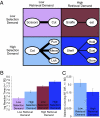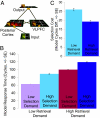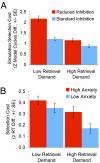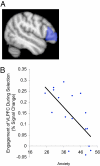Neural inhibition enables selection during language processing
- PMID: 20813959
- PMCID: PMC2944747
- DOI: 10.1073/pnas.1002291107
Neural inhibition enables selection during language processing
Abstract
Whether grocery shopping or choosing words to express a thought, selecting between options can be challenging, especially for people with anxiety. We investigate the neural mechanisms supporting selection during language processing and its breakdown in anxiety. Our neural network simulations demonstrate a critical role for competitive, inhibitory dynamics supported by GABAergic interneurons. As predicted by our model, we find that anxiety (associated with reduced neural inhibition) impairs selection among options and associated prefrontal cortical activity, even in a simple, nonaffective verb-generation task, and the GABA agonist midazolam (which increases neural inhibition) improves selection, whereas retrieval from semantic memory is unaffected when selection demands are low. Neural inhibition is key to choosing our words.
Conflict of interest statement
The authors declare no conflict of interest.
Figures





References
-
- Iyengar SS, Lepper MR. When choice is demotivating: Can one desire too much of a good thing? J Pers Soc Psychol. 2000;79:995–1006. - PubMed
-
- Sethi-Iyengar S, Huberman G, Jiang W. In: Pension design and structure: New lessons from behavioral finance. Mitchell OS, Utkus S, editors. Oxford: Oxford University Press; 2004. pp. 83–95.
-
- Redelmeier DA, Shafir E. Medical decision making in situations that offer multiple alternatives. JAMA. 1995;273:302–305. - PubMed
-
- Badre D, Wagner AD. Left ventrolateral prefrontal cortex and the cognitive control of memory. Neuropsychologia. 2007;45:2883–2901. - PubMed
Publication types
MeSH terms
Substances
Grants and funding
LinkOut - more resources
Full Text Sources
Research Materials

